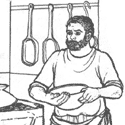|
Grain has two key advantages over potatoes - 1 - it is more shelf stable 2 - it has more calories per weight, so it travels better. Potato is typically a superior crop for local consumption for all of the reasons listed above, but if you want to ship a shitload of food from Egypt to put into reserves in case some Huns come along and start wrecking poo poo in Italy, grain is far superior. One neat thing I heard once on some kind of history of food podcast though is that Andean peoples used to take potatoes up into high altitude areas and smash em and let them naturally freeze dry, then bring em down and store them, thus creating something virtually identical to modern instant mashed potatoes. I can't imagine that's more labour than milling and baking grain.
|
|
|
|

|
| # ? Jun 10, 2024 20:26 |
|
Phanatic posted:the peanut butter (or jalapeño cheese which really kicks the peanut butter’s rear end) my biggest takeaway from MRE eating Steve is a MRE peanut butter packet will outlive us all
|
|
|
|
How lethal would a tonsillectomy have been in days gone by? Also my mom gave birth to my younger brother by C-section, so...
|
|
|
Davin Valkri posted:How lethal would a tonsillectomy have been in days gone by? Also my mom gave birth to my younger brother by C-section, so... I’d assume that they could do it and cauterize the snips with what they had at the time. But the fact that your patient was conscious and aware of all the pain must have hosed those people up. I know doctors today that are messed up with some of the crap they’ve had to do even with modern practices and anesthesia.
|
|
|
|
|
TK-42-1 posted:sorry about your dingus. Shoulda been drinking boosts instead. I actually like the chocolate ones
|
|
|
|
HEY GUNS posted:i found seeing like a state disappointing, but i find most things that rely on "case studies" from many times and places to be shallow. that doesn't surprise me, and I don't think its wrong. With this kind of work I don't necessarily judge it by the same criteria as I would an academic history, since I feel it serves a different purpose. As I recall I was first recommended the book by a lawyer, for whom how states "see" is not at all an academic problem, but is extremely and directly relevant to their day to day profession. Simply stated, my main take-away from the book is that "decision making by leaders and governments is limited by the information available." Said like that it doesn't seem very profound, it's almost a truism. The interesting part is exploring how this constraint shapes historical people's and our own way of thinking about problems. The value of the work is less in what it tells us about history, and more in how it helps us frame our own thoughts. In this way the book veers away from hard history, which I believe should be based in hard empiricism, and more towards the philosophical. If what you want is history that can be a weakness, but sometimes I just want something else. I like reading works from many fields and its interesting see the different sorts of norms and methods they develop. I feel like within a field, there's usually good reason for them to adopt the methodologies they have, even if they aren't necessarily appropriate in other settings. I remember in this thread at some point bewbies was trying to talk about some silly hypothetical, idk probably something about gay black battleships, and another poster started getting sassy all like "uh this is stupid and not history, why are you cluttering up the thread with it?" However if you're actually in the business of military organization and planning, being able to work through hypothetical scenarios is supremely practical. In the middle of a war, you can't just stop everything and start turning over documents to come to a complete understanding of the relation between events. You have to be able to make snap decisions based on limited information. The value of studying history in such circumstances is in the broad lessons that you can take away and apply in your present circumstances. That ultimately making generalizations and extrapolations, often by necessity beyond what's justified by the most rigorous methods.
|
|
|
|
Medieval peasant lifestyle discussion reminded me of this Kate Beaton comic on just this topic
|
|
|
|
It's okay he barely eats any food anyway so there can't be too many smelly bacteria in there.
|
|
|
|
Randarkman posted:Yeah that's where it comes from. In many cases today there's a lot of pageantry, ceremony and importance to it that wasn't really there back in Medieval times. It's not really important as 'coming of age' as much as a 'celebration', at least here in Denmark. It has developed to a form where your 15th birthday is supposed to be a big party with bigger presents than normal, and kids who want to get confirmed (provided they are already baptized, of course, otherwise they have to get baptized too). I'm not baptized, nor did I want to get confirmed, so I was what we call "nonfirmed" in slang, had a big party and got drunk with my friends. We're getting off-topic, but I actually think it's kind of a shame that this is where the tradition's gone. There's not any functional rite of adulthood in my country, and just getting presents and drinking a lot doesn't actually welcome you to adult society. FuturePastNow posted:my biggest takeaway from MRE eating Steve is a MRE peanut butter packet will outlive us all Nutella will outlast the nuclear winter.
|
|
|
|
HEY GUNS posted:they also think things are "natural" that are actually the result of constant tending, like their teeth. so even if a modern person just hosed off into the woods, they're coasting on a lifetime of modern healthcare, dental care, and nutrition. it's not only that you have your current state of health now, it's that you did not have a lifetime of lovely health behind you. It was definitely fitting that the guy from Into the Wild died pretty quickly when he completely cut himself off from society and tried living au naturel.
|
|
|
|
Edgar Allen Ho posted:Early Antarctic explorers literally couldn’t consume enough calories to avoid losing weight, even when they had plenty of dense food. I dunno how many calories your body needs to maintain its temperature in that cold but it’s a lot. IIRC Scott and his men on their final man-hauling expedition were estimated to be burning 7k-9k calories per day each, and their rations were only supplying them 4.5k per day on the way out and 3.8k on the way back. Even with modern equipment and nutrition it's nearly impossible to keep a balanced or positive calorific intake when man-hauling in polar conditions - from the start you are slowly starving yourself and it's only a case of hoping you reach your destination before you weaken so much you can't keep going (of course, due to other factors and errors Scott's party used up their slim safety margin a s simply ran out of energy). There was also something relevant to Hey Gun's point about the lack of nutritional knowledge in past societies, even in the relatively recent and scientific time of 1912. Scott's rations, we know now, were insufficient in both the foodstuffs they took and the balance; they were still unaware of the actual cause of scurvy (Casimir Funk would discover vitamins and their function almost exactly at the same time as Scott was freezing to death in his tent) and they did not appreciate the benefits of fat as both a dense energy source and a way of maintaining weight - they thought that protein (first described in the 1820s, chemically analysed in 1902 but not fully understood nutritionally until the 1920s) were most important and their rations consisted of something like 50% sugar and carbs, 25% fat and 25% protein. We now know that it would have done them better if the mix had been more like 50/40/10.
|
|
|
|
Siivola posted:It's okay he barely eats any food anyway so there can't be too many smelly bacteria in there. Head tapping meme: Can't have bed breath if you have no bed.
|
|
|
|
Tias posted:It's not really important as 'coming of age' as much as a 'celebration', at least here in Denmark. It has developed to a form where your 15th birthday is supposed to be a big party with bigger presents than normal, and kids who want to get confirmed (provided they are already baptized, of course, otherwise they have to get baptized too). I'm not baptized, nor did I want to get confirmed, so I was what we call "nonfirmed" in slang, had a big party and got drunk with my friends. Well, I'm personally familiar with the Norwegian version and here it's still a pretty important celebration with a prominent coming of age theme (also no 15-year old drinking at least not in parties with your adult family members, which confirmations always will be here, then again Norway's alcohol legislation is much stricter than Denmark's). It's also worth noting that there's also developed a tradition of secular/civil/humanist confirmation (organized by the humanist society) for those who have not been baptized and/or who would rather excize the religious elements of the ceremony. In alot of ways they are still very similar though in that you have a period of education beforehand (typically human rights and such for the secular variant) and then a long, boring, pompous ceremony (in a church if traditional or in some place like a theater or town hall if secular) for all the confirmants at once followed by a private family party for each one. I think the split now is about 50/50 traditional and secular. I did secular, mostly because I was not baptized (though like most others I was still registered as a Church member, which I did not discover until many years later), though I know of several examples of people my age getting baptized to get a regular confirmation with their friends (back then I think there were more traditional than secular confirmations as well). Having been the subject of a secular one and having sat through several others (of both kinds) I have to say that I'd rather sit through one of the traditional ceremonies again. Somehow they've always been shorter and felt way less boring than the secular ones I've attended (maybe we beat them out in the education, but that was pretty dull and poorly presented as well). A bit off-topic but kind of interesting to see the differences here. One friend of mine actually had a 'nonfirmation' in that they used that word to describe it, but otherwise it wasn't really like you describe for Denmark, they just dispensed with everything except the family party at the end.
|
|
|
|
Milo and POTUS posted:Aren't potatoes calorie dense as hell? Is it just the fact that grain would have far less void space than potatoes why it'd be more valuable by the cart Potatoes are wet. That’s what’s holding them down in energy density. Phanatic posted:On the other side, there’s the example of a friend of mine who was SF in Gulf War 1, who was eating three MREs per day, which is about the maximum about of caloric intake that you can expect from people, and still losing weight. Polar explorers eat butter by the stick. It’s an expedient method of taking in energy. Pædiatricians sometimes prescribe a stick of butter per day. If the kid doesn’t put on weight with that diet, there is a digestive issue. CommonShore posted:One neat thing I heard once on some kind of history of food podcast though is that Andean peoples used to take potatoes up into high altitude areas and smash em and let them naturally freeze dry, then bring em down and store them, thus creating something virtually identical to modern instant mashed potatoes. I can't imagine that's more labour than milling and baking grain. You can’t imagine that hauling sacks of potatoes up a mountain, in the cold, is more work than making bread? I can. That sounds like an ordeal. I’ll take the staff of life if I have a choice, even if I had to put my nose to the grindstone. Mills have historically used a lot of waterpower and windpower and animal power. Only the last of those has the potential to haul potatoes up a mountain, and the potential isn’t great. P.S.: I’d be interested in the podcast if you can recall which it is.
|
|
|
|
Milo and POTUS posted:I want to try breadfruit so bad. Just seems like somsething I'd enjoy It’s an interesting fruit. If you like plantains, you’ll like breadfruit. This talk about the Andes reminds me of one of the finest of fruits, the cherimoya. They’ve been cultivated in South America for three millennia. A literal translation of the name in Quechua is “cold seed”. They will not grow in the tropical lowlands, but they also they cannot withstand much frost. They are adaptable to some mediterranean climates, so in addition to their native range, they’re grown in Spain, Israel, California, and Australia. Try one if you have a chance. Platystemon fucked around with this message at 13:36 on Oct 20, 2019 |
|
|
|
Goon teaching time! I'm on the lookout for siege/fortification instruction, preferably from around the middle ages. I have an insane campaign idea involving dwarven fortresses and learning geography!  trraaappss.. In particular: - Did any particular natural features go well with a given fortification (rivers and gorges make great natural defensive areas, what do you build in them to increase their worth?) - What are good defense works, and what do you need of materials and skills to build them? - What kind of fortification or trap is good to build in which soil type? What kind of clay content was thought ideal for moat-building, which kinds of meadows where preferred for ditch building, so on - Any wacky or discontinued trap ideas that -might- have flied with a little magic or dwarven science added Please go crazy, though I am only in first year geography and know nothing about fortifying, so accessible works would be appreciated. Randarkman posted:Well, I'm personally familiar with the Norwegian version and here it's still a pretty important celebration with a prominent coming of age theme (also no 15-year old drinking at least not in parties with your adult family members, which confirmations always will be here, then again Norway's alcohol legislation is much stricter than Denmark's). It's also worth noting that there's also developed a tradition of secular/civil/humanist confirmation (organized by the humanist society) for those who have not been baptized and/or who would rather excize the religious elements of the ceremony. In alot of ways they are still very similar though in that you have a period of education beforehand (typically human rights and such for the secular variant) and then a long, boring, pompous ceremony (in a church if traditional or in some place like a theater or town hall if secular) for all the confirmants at once followed by a private family party for each one. Yeah, there's no ritual to it if you don't do the church, though my family did hold some speeches and dispense a little wisdom on me, which seems to be common, at least in more bourgeois families. There is more engagement with and interest in the folkekirke in Norway than in Denmark though, isn't there? Platystemon posted:This talk about the Andes reminds me of one of the finest of fruits, the cherimoya. They’ve been cultivated in South America for three millennia. Oh poo poo, I actually picked up a little Que'chua! Great language, and colourful too.
|
|
|
|
Phanatic posted:It’s really difficult for a human to ingest that sort of caloric load. Michael Phelps was working hard just to get that much food down his gullet.
|
|
|
|
feedmegin posted:I had phimosis develop as a teenager and let me tell you life would have suuuucked for me before they developed anaesthesia, at the very least.
|
|
|
|
Tias posted:Yeah, there's no ritual to it if you don't do the church, though my family did hold some speeches and dispense a little wisdom on me, which seems to be common, at least in more bourgeois families. Possibly, Norway only recently moved away from the state church concept (though I think it still applies mostly, the change is mostly just cosmetic). Although not commonly seen as such, in relation to it's neighbors Norway has long been and still is the most Christian of the Scandinavian countries, though this has often manifested itself in the popularity of Evangelical movements of various sorts. The increased importance of the confirmation ritual might be down to that, but could also be that the educational aspect of the ritual might have been more important in Norway, being larger and with a smaller and more dispersed population (those teacher-priests who travelled to the farms and taught the children to prepare them for confirmation were pretty important). The educational aspect is still emphasized in both the traditional/church variant and secular/humanist variant. The structure of the two is essentially identical, with a couple of months of after school classes (once or twice a week IIRC) and maybe a weekend retreat, they only differ by content.
|
|
|
|
BalloonFish posted:There was also something relevant to Hey Gun's point about the lack of nutritional knowledge in past societies, even in the relatively recent and scientific time of 1912. Scott's rations, we know now, were insufficient in both the foodstuffs they took and the balance; they were still unaware of the actual cause of scurvy... they didn't know why you had to eat fruits, vegetables, and vinegar to not get scurvy, only that you did. they also called it the dutch disease and believed spanish people couldn't get it. considering the spanish diet, they were kind of right--but again, for the wrong reasons
|
|
|
|
Dance Officer posted:It was definitely fitting that the guy from Into the Wild died pretty quickly when he completely cut himself off from society and tried living au naturel. it's totally possible to live like primitive humans if you know what you're doing, the point is that modern life gives us much more of a cushion in case anything doesn't work perfectly. HEY GUNS fucked around with this message at 14:45 on Oct 20, 2019 |
|
|
Platystemon posted:Potatoes are wet. The product he’s referring to is chuño, which is still made today in these isolated Andean communities. They don’t need to haul the potatoes up the mountain because they already live there; potatoes are some of the few plants that grow there. It’s basically a naturally freeze dried potato. You repeatedly expose the potatoes to freezing nights and the heat of the sun at high altitudes while squeezing the water out, which creates a shriveled white or black potato that will stay good pretty much forever.
|
|
|
|
|
Into the Wild guy specifically crossed a river that floods significantly in spring from snow melt and then got stuck when he couldn't cross back across it in summer. I find it real hard to believe a hunter-gatherer band in the far north would be bamboozled by such a river. e: from what I understand even today in northern Canada and Alaska people living In A Society still have to plan travel around whether the snowmelt has happened or not. Edgar Allen Ho fucked around with this message at 14:56 on Oct 20, 2019 |
|
|
|
Davin Valkri posted:How lethal would a tonsillectomy have been in days gone by? Also my mom gave birth to my younger brother by C-section, so... They’ve been doing tonsillectomies for a couple of thousand years, though given what the patients I anaesthetise for the procedure get as a likely pain-related response to the gag/surgical stimulus while they’re out, your experience would be life-definingly horrible. Also lol at the idea of medieval surgeon doing this procedure on a peasant except for practice.
|
|
|
|
Edgar Allen Ho posted:e: from what I understand even today in northern Canada and Alaska people living In A Society still have to plan travel around whether the snowmelt has happened or not. I mean, not for much longer
|
|
|
|
HEY GUNS posted:phimosis has been operable for a long time, louis xvi had it and had an operation. Hence why I mentioned anaesthesia. It's not 'whether it could be done', people were doing it voluntarily in the ancient world to convert to Judaism; it's how thoroughly unenjoyable the experience would be. Take it from me, having your dingus look like corned beef for months after an anaesthetised operation is already unpleasant enough.
|
|
|
|
Randarkman posted:Yeah that's where it comes from. In many cases today there's a lot of pageantry, ceremony and importance to it that wasn't really there back in Medieval times. Scandinavia wasn't prosperous in the 18th century. You also couldn't get married unless you were confirmed, and premarital sex was illegal, so there were incentives to learn to read.
|
|
|
|
HEY GUNS posted:it's such an interesting detail that the spanish knew how to treat scurvy in the 1500s and 1600s, then i guess we lost that, then we rediscovered it The cure for scurvy was discovered and forgotten multiple times in history. One of the reasons for this is that substances can lose their vitamin C in certain conditions. Eg. fresh meat from non-humans and guinea pigs have it, but most of the various processed meat products don't. And even lemon and lime juices can lose it if kept in wrong kind of containers.
|
|
|
|
They knew (generally) what cured scurvy, they didn't know why it cured scurvy. There's a difference.
|
|
|
|
ChubbyChecker posted:The cure for scurvy was discovered and forgotten multiple times in history. One of the reasons for this is that substances can lose their vitamin C in certain conditions. Eg. fresh meat from non-humans and guinea pigs have it, but most of the various processed meat products don't. And even lemon and lime juices can lose it if kept in wrong kind of containers. To complicate things further, if you've been eating a lot of vitamin C you can sort of coast for a few months until you get scurvy, which means spanish sailors wouldn't have gotten it on the atlantic run but would have when sailing the pacific. If you're a 16th century Spanish doctor, all you know is something about the Atlantic means your sailors do not get scurvy, and something about the Pacific means they might. What is that something? How do you find out?
|
|
|
|
And with the discovery of germ theory, scientists supposed scurvy had to be caused by some kind of germ, so they recommended thoroughly boiling and preserving rations - which destroyed the vitamin C. Unrelated question, how did bullet manufacturing change between World War I and World War II? Were there new industrial processes that made it more efficient, or was it simply a linear increase in factories to produce more bullets?
|
|
|
|
ChubbyChecker posted:The cure for scurvy was discovered and forgotten multiple times in history. One of the reasons for this is that substances can lose their vitamin C in certain conditions. Eg. fresh meat from non-humans and guinea pigs have it, but most of the various processed meat products don't. And even lemon and lime juices can lose it if kept in wrong kind of containers. This was why it took so long to nail down (really only once Vitamins were discovered and we finally understood the cause and mechanism, not just the trial-and-error effects). James Lind experimentally proved that citrus juice was an antiscorbutic in the 1750s but he still maintained the consensus belief that it was a physical ailment caused by prolonged hard work in damp conditions. Captain Cook took lots of experimental preventatives/cures with him on the Endeavour and famously didn't lose a single man to scurvy. He came down on the side of malt as the best preventative, but we now know that his success was mostly due to his voyage consisting mostly of relatively short hops between provisioning stops and his seemingly trivial (and very unpopular) order banning the sale of 'slush' from the cooking kettles - instead of the coppers being regularly scraped clean they built up a layer of fat and varnish which prevented the cooked food getting laced with copper compounds which reduce vitamin uptake, so his crew were in better shape at the start of the longer legs of their journey when they would ordinarily be at risk of scurvy. When citrus juice came to the fore as the primary antiscorbutic the preferred fruit was lemons, but the British opted for the cheaper and more readily-available limes which it was also hoped would be more powerful because of their greater acidity. But limes are actually much lower in Vit.C than lemons and the crews were issused with lime juice, which in the preparation, storage and serving (even just pouring it from the cask to a copper jug to pass around the messdeck) destroyed virtually all the antiscorbutic properties, so for a while it seemed that citrus was a dead end. At about that time the RN began getting into Arctic exploration and it turned out that fresh meat was a powerful cure for scurvy. But even then it wasn't understood that to be really effective it had to be certain animals (mostly seals, in the Arctic) and it had to be the (as we now know to be vitamin-rich) internal organs. As primates, humans are very unusual amongst mammals in that we can't metabolise our own Vitamin C, so attempts to provoke and cure scurvy experimentally on other animals failed or produced bizarre false-positives. It wasn't until 1907 that it was found that guinea pigs can also get scurvy and it wasn't until the 1930s that this was used, together with the new knowledge of vitamins, to properly understand the mechanisms behind scurvy and what sort of condition it actually was.
|
|
|
|
I can’t speak to the presses and any improvements in manufacturing processes (streamlined factory work flows etc) but the basic composition of the cartridges was the same. A case from 1914 is more or less identical to one from 1939 as is the bullet and powder. Now, there are going to be minor differences here and there. Wartime moves to mild steel jackets for bullets, changes in powder mix, etc. [url= https://www.petersoncartridge.com/our-difference/drawing-brass/] Here is how a brass case is made today, for example. [/url] This is a fancy company making higher end brass so some of the steps could be eliminated and certainly were with bulk military stuff, but the broad strokes are informative. Nothing they’re showing there couldn’t be done with 1914 technology. Note that metallic cartridges with primers in the base of the case (ie the modern cartridge as we know it) date from the 1850s. By the time you get to the world wars the basic tech was very mature and any improvements in production speed are going to be factory process poo poo not the raw fundamentals of how they are built.
|
|
|
|
When I was visiting a friend at Berkeley in the mid 90s I was shown a dude who lived entirely off chicken and white sauce pizza and managed to come down with the first case of scurvy in living memory at the college. Drink your Mountain Dew kids.
|
|
|
|
HEY GUNS posted:he didn't know how to hunt or what plants to eat. he was also completely alone, across a difficult river from anyone else, which would have been unusual(?) for a member of a travelling band of foragers or something The book I read on the Comanche suggested that when they first migrated to the southern Great Plains, they didn't know what local plants were edible or could be easily foraged for, which is why they ended up eating an all-meat* diet. If you know what you're doing, you can live off what you forage, but it ain't easy figuring all that out on your own. Although if you're trying to eat only what you can forage, I imagine that'd be harder in areas where so much of the local environment has been developed into housing, leaving much less range for foragable plants to grow. *supplemented with plants bought or stolen from actual agricultural societies.
|
|
|
|
LingcodKilla posted:When I was visiting a friend at Berkeley in the mid 90s I was shown a dude who lived entirely off chicken and white sauce pizza and managed to come down with the first case of scurvy in living memory at the college.
|
|
|
|
There’s been a handful of cases of college students getting scurvy. It takes an extremely tiny amount of Vitamin C to prevent it and symptoms don’t show for a month or more, so only the most supremely lazy ones got it.
|
|
|
|
|
Reposting!Tias posted:Goon teaching time! I'm on the lookout for siege/fortification instruction, preferably from around the middle ages. I have an insane campaign idea involving dwarven fortresses and learning geography! In particular, I'd like to know what kind of thoughts have been made on soil and rock types by defensive engineers through the ages.
|
|
|
|
chitoryu12 posted:There’s been a handful of cases of college students getting scurvy. It takes an extremely tiny amount of Vitamin C to prevent it and symptoms don’t show for a month or more, so only the most supremely lazy ones got it. I’m a grown rear end man I’ll eat what I want.
|
|
|
|

|
| # ? Jun 10, 2024 20:26 |
|
Tias posted:Goon teaching time! I'm on the lookout for siege/fortification instruction, preferably from around the middle ages. I have an insane campaign idea involving dwarven fortresses and learning geography! Try dwarf fortress and see! Cage traps work well and will capture anything from a kobold thief to a rampaging titan.
|
|
|











































